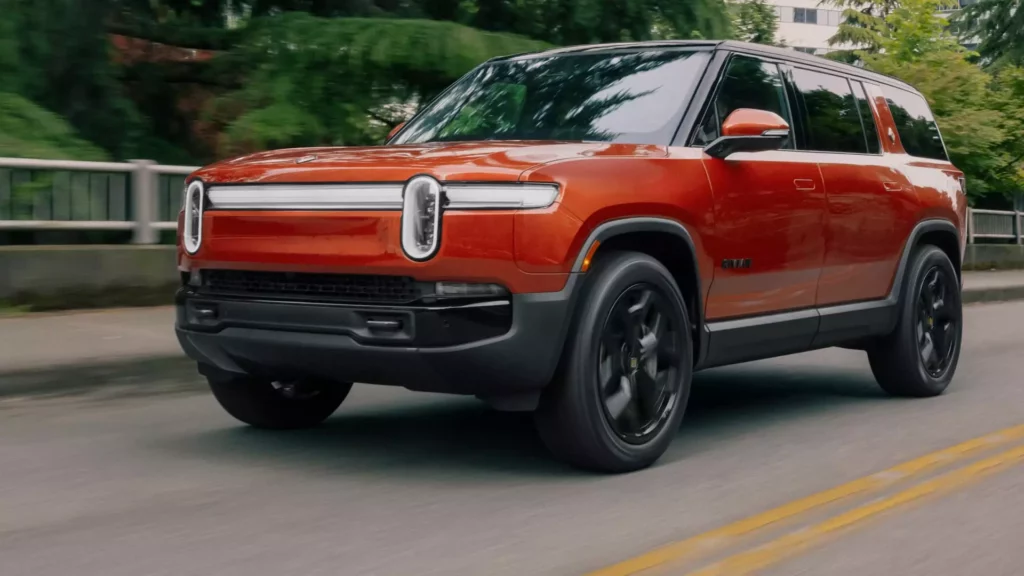![]()
Rivian Automotive recently revealed the redesign of its all-electric R1 pickup and SUV models, showcasing improvements in range, performance, and computing power with the integration of Nvidia chips. The 2025 model-year vehicles boast significant upgrades, despite maintaining a similar outward appearance to their predecessors. Rivian disclosed that over half of the hardware components in the second-generation products have been modified, along with the reengineering of batteries and electrical architectures, which serve as the core intelligence of the vehicles. The company’s CEO and founder, RJ Scaringe, emphasized the commitment to advancing their flagship R1 vehicles, ensuring superior quality and performance with no compromises. The revamped R1S and R1T models have been taken to new heights, pushing the boundaries of technology to deliver the most capable products in Rivian’s history.
One of the most notable enhancements in the updated vehicles is the significant boost in computing power, which Rivian claims provides a tenfold increase in performance compared to the previous system. The implementation of dual Nvidia DRIVE Orin processors powers the “Autonomy Compute Module,” enabling advanced driver-assistant features. Rivian also announced the availability of a “premium version” of the system, offering an expanded set of capabilities including hands-free driving for specific periods. However, drivers are required to remain attentive to the road conditions at all times, as the system is designed to assist rather than replace human supervision.
In a strategic move aimed at boosting sales momentum and expanding its market reach, Rivian plans to introduce more affordable “R2” models, anticipated to be priced around $45,000 upon their anticipated launch in the first half of 2026. This new line of lower-priced vehicles holds significant importance for Rivian’s growth strategy, particularly considering the slowdown in sales of its existing models amid a challenging environment for electric vehicle sales across the industry. To optimize operational efficiency and reduce capital expenditure, the company has undertaken measures such as workforce reduction, cost-cutting initiatives, and operational streamlining at its Illinois plant. Additionally, Rivian has halted the construction of a new plant in Georgia, resulting in substantial cost savings amounting to $2.25 billion.
Despite the innovative product upgrades and strategic business decisions, Rivian continues to face financial challenges, characterized by ongoing cash burn and substantial losses. The company reported a staggering loss of $1.45 billion in the first quarter of the year, contributing to a decline of approximately 50% in its stock value year-to-date. Rivian’s stock performance has been under pressure due to concerns surrounding its financial stability and the sustainability of its growth trajectory. Rivian’s ability to address its cash flow issues and achieve long-term profitability will be critical in determining its future success and investor confidence.
The latest iteration of Rivian’s battery packs features a continuation of the “2170 cylindrical cell” configuration, coupled with advancements in pack enclosure design using large high-pressure die castings to simplify manufacturing processes and reduce overall weight. The tri- and quad-motor variants of the vehicles boast new drive units developed in-house by Rivian, offering superior performance capabilities. The top-end quad-motor vehicle now delivers an impressive 1,025 horsepower and 1,198 pound-foot of torque during Launch Mode acceleration, achieving a remarkable 0-60 mph time of just 2.5 seconds. The redesigned battery packs and drive units enhance the overall performance and efficiency of the vehicles, setting a new benchmark for electric vehicle technology.
In addition to performance upgrades, the 2025 R1S and R1T models feature enhanced interior design elements, offering a more luxurious and refined experience for occupants. Rivian has introduced a fully redesigned software interface to improve user experience and functionality, reflecting the company’s commitment to innovation and customer satisfaction. The updated software interface integrates seamlessly with the advanced computing system, providing users with intuitive controls and access to essential vehicle features. Furthermore, charging times have been significantly reduced, with all models capable of adding up to 140 miles of range in just 20 minutes, underscoring Rivian’s focus on convenience and usability for its customers.
Rivian’s latest advancements in electric vehicle technology demonstrate a commitment to innovation, performance, and user experience. The integration of Nvidia chips, enhanced computing power, and improved battery technology represent a significant leap forward in the electric vehicle market. Despite facing financial challenges and market pressures, Rivian’s strategic initiatives and product improvements position the company for future growth and success in a competitive industry landscape. By prioritizing technological innovation, product excellence, and customer satisfaction, Rivian is poised to redefine the electric vehicle segment and drive the transition towards sustainable mobility solutions.

Leave a Reply